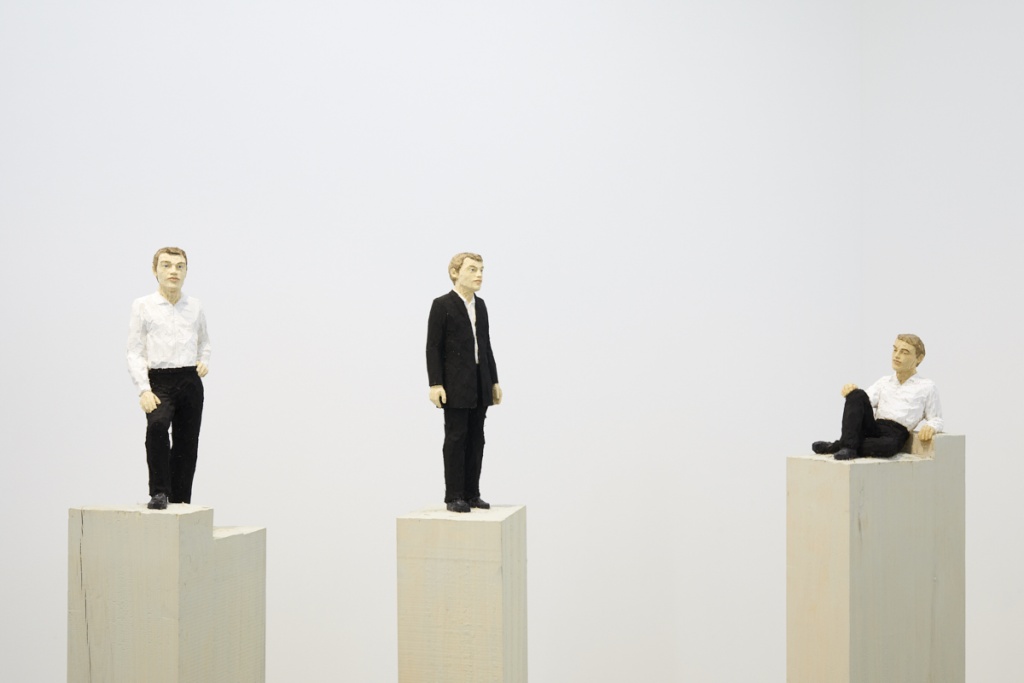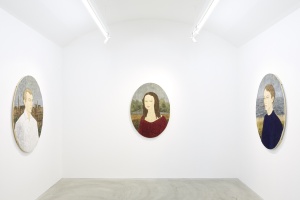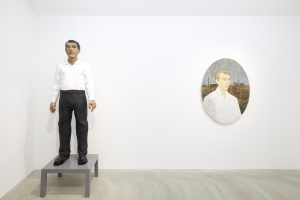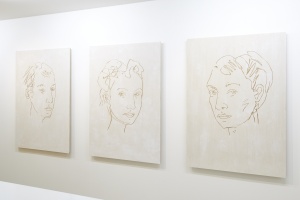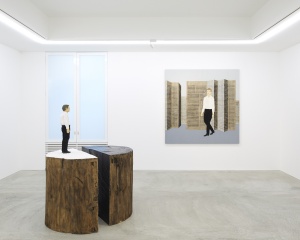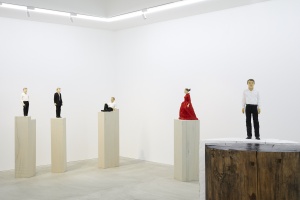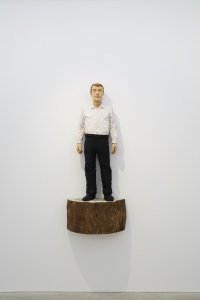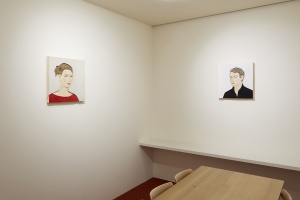Tomio Koyama Gallery is pleased to present an exhibition with German sculptor Stephan Balkenhol.
Balkenhol has presented works in numerous exhibitions internationally, and his first solo exhibition in Japan, “Stephan Balkenhol: Skulpturen und Reliefs” held in 2005 at the National Museum of Contemporary Art, Osaka, and Tokyo Opera City Art Gallery, received significant recognition and acclaim. With previous exhibitions at Tomio Koyama Gallery in 2007 (Kiyosumi) and in 2011 (Kyoto), this marks Balkenhol’s third solo presentation with the gallery in 8 years, and will feature a selection of his new and most recent works.
【About Stephan Balkenhol】
Stephan Balkenhol was born in 1957 in Hesse, Germany. From 1976 he studied at the Hamburg School of Fine Arts where artists including Nam June Paik and Sigmar Polke had taught at the time, and received the tutorship of renowned minimalist sculptor Ulrich Rückriem.
In the 1980s he began to explore human figures within his practice, declaring: “I must reinvent the figure to resume an interrupted tradition.” Ever since he has consistently appropriated people, animals, and architecture as motifs to produce colored bronze works and wooden sculptures characterized by a rough textual quality, from anonymous human figures with tall pedestals carved from singular blocks of wood to reliefs that appear to serve as their backdrop.
Balkenhol’s works have continued to fascinate its viewers, presenting a uniquely “ordinary yet extraordinary” view of the world that brings together depictions of human figures and animals with elements of minimalism, while also permeating with a subtle sense of humor and conveying his endless interest towards human beings and other living creatures.
“What can also be considered as having influenced Balkenhol’s work was his experience of viewing the ‘Realism’ exhibition (curated by Jean-Christophe Aumas) at Documenta 5 in 1972 at the age of 15, and his determination to ‘create a personal and unique form of pop art’ in response to the various abstract paintings and sculptures he encountered at the time.”
(Neal Benezra, “Stephan Balkenhol: Refiguring a Tradition,” Stephan Balkenhol Sculpture and Drawings, exhibition catalogue, Hirshhorn Museum, 1995)
Balkenhol has held numerous exhibitions throughout the world (please refer to the following URL for list of exhibitions http://tomiokoyamagallery.com/en/artists/stephan-balkenhol/#artist-biography), with works included in prominent collections internationally, including the Art Institute of Chicago, Hirshhorn Museum and Sculpture Garden, The Broad Art Foundation (Santa Monica), Los Angeles County Museum of Art, Ludwig Forum für Internationale Kunst, Kunstmuseum Bonn, and the Museum für Moderne Kunst. In Japan his works are housed in the collections of The National Museum of Art, Osaka and The National Museum of Modern Art, Tokyo.
【About Balkenhol’s Works: Subjects that Appear Animated and Alive】
As Balkenhol himself mentions, a particular aspect he places emphasis on in the production of his work, is that the subjects appear animated and full of life. This is also apparent in the distinct expressions of his sculptures.
The figures that serve as his motifs are as he describes, “Mr. Everyman” –“someone from somewhere” who indeed could also be “anyone from anywhere.” These unassuming figures have no specific model, and are instead a manifestation of variously overlapping image sources such as figures in newspaper articles and passersby encountered on the street. With each of their faces appearing devoid of emotion and expression, at first glance they may not seem animated at all.
Balkenhol however, describes the reason for this as follows.
“…The figures are all relatively similar, having no distinct expression such as appearing joyous or sad. In essence, I engage in ‘exploring a certain facial expression’ that must atmospherically be able to evoke all such emotions. I find this to be more emotive and inspiring rather than affixing a specific expression to my figures as often is the case in expressionist works of art. In doing so, the figures can look melancholic one moment, and full of joy the next…”
(Interview with Stephan Balkenhol: “A Dialogue with the Material,” interviewed by: Yukako Ando, Bijutsu Techo, November Issue, 2005)
Balkenhol’s works by nature give rise to different ways of viewing and points of attention that are unique to each and every viewer. We as viewers are able to project our own memories and awareness onto the works, and find pleasure in seeking out expressions that are individually visible to us. In this respect, the works ‘come to life’ through the viewer’s experience and engagement with them.
This is further reflected in the roughly carved surfaces of his works.
“This (the rough surface) is also purely for reasons of creating a ‘lively and animated’ atmosphere (…) when you are used to using machinery and tools, making a sculpture becomes no different to producing a painting or drawing. At times I find great pleasure in working quickly, as if I were making a simple sketch.”
(Interview with Stephan Balkenhol: “A Dialogue with the Material,” interviewed by: Yukako Ando, Bijutsu Techo, November Issue, 2005)
【The Three-dimensionality and Two-dimensionality of the Works, Sculpture – Space – Audience】
As evident from his aforementioned discussions on drawing, Balkenhol’s works artfully manipulate three-dimensionality and two-dimensionality through his human figures as well as reliefs and drawings that serve as their background. By pursuing the relationship between the works and the spaces in which they are presented, he succeeds in expanding his world of imagination in a more three-dimensional manner.
Balkenhol also mentions as follows regarding the size of his works.
“At times a small work can have a more monumental effect than a large work. They evoke an image, or in a sense carry the surrounding space. (…) when you place a small sculpture in a large space, it can actually make it stand out. It intrigues viewers, making them want to venture closer to see what’s there. In this way, I am interested in how sculpture and space relate to and engage with the viewer. On the contrary, there are often instances where a large sculpture can work more effectively in a small space.”
(Interview with Stephan Balkenhol: “A Dialogue with the Material,” interviewed by: Yukako Ando, Bijutsu Techo, November Issue, 2005)
The relationship between three-dimensionality and two-dimensionality is particularly most apparent in Balkenhol’s reliefs. Shihoko Iida, Independent curator (former curator of Tokyo Opera City Art Gallery), speaks about the relationship between his relief works and photography as follows.
“Balkenhol’s works have a strong relationship to photography, as can be discerned from the way in which they are described as ‘polaroid in wood.’ The human figures and cityscapes that he employs as his motifs are highly contemporary, and the rough manner in which he carves his sculptures evoke an air of speediness. In the sense that they capture the moment, they permeate with an immediacy reminiscent of snap shots.”
(“Stephan Balkenhol: Skulpturen und Reliefs” exhibition catalogue, National Museum of Contemporary Art, Osaka, / Tokyo Opera City Art Gallery, 2005)
Balkenhol ventures beyond the concepts of ‘sculpture’ we imagine, taking us on a lively and animated journey of imagination while pursuing the relationship between the exhibition space and the works, and further incorporating the perspective of the viewer.
We hope viewers will take this opportunity to explore and engage with the world of Balkenhol’s new works, which will be presented for the first time in Tomio Koyama Gallery’s Roppongi space.
—————————————————————————————–
For press inquiries, please contact:
press@tomiokoyamagallery.com (Makiko Okado)
—————————————————————————————–

